Dive gear or equipment allows us to enter the hostile environment of the underwater world that would be fatal without, basically we are not fish and can’t breath without help :). Innovations that have allowed us to venture underwater have been around for a long long time since ancient divers using hollowed out reeds as snorkels and shells as goggles, but really dive equipment started in the 18th century with the invention of the air pump to allow sustained underwater activity. Today we no longer think of guys in big suits with helmets, lead boots and air hoses but of Scuba as invented in the 40’s by Cousteau and Gagnan then known as the Agua Lung.
Things have moved a long way since then, with hybrid materials making ones journey into the underwater world easier and more comfortable allowing one to dive in even extreme conditions and inhospitable environments, advanced gas mixtures allowing longer and deeper penetration (no sniggering guys) whilst reducing the risk associated with breathing gases under pressure and computers allowing safer diving through precision measurement of gas absorption.
Here is an overview of the gear you may need to blow some bubbles safely.
BCD
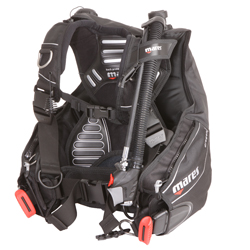 A Buoyancy Control Device or BCD is used to assist the diver with their buoyancy whilst underwater and keeping them buoyant whilst on the surface. A BCD is basically a jacket with a airtight bladder that is worn over the wetsuit, the bladder is filled with air from the cylinder via a low pressure hose.
A Buoyancy Control Device or BCD is used to assist the diver with their buoyancy whilst underwater and keeping them buoyant whilst on the surface. A BCD is basically a jacket with a airtight bladder that is worn over the wetsuit, the bladder is filled with air from the cylinder via a low pressure hose.
Dive computer
 Dive computers are common place in modern diving, although we are taught to plan our dives and dive our plans using dive tables many these days just rely on their computer to work out all the fine details and keep one safe. Dive computer in their basic form just process depth and time information against internal tables to tell you when to ascend, in advanced form they take into account body mass, heart rate, air consumption rate, air mixes, decompression etc. They may also include thermometers and compasses and when connected to your PC they draw pretty graphs of your dive profile.
Dive computers are common place in modern diving, although we are taught to plan our dives and dive our plans using dive tables many these days just rely on their computer to work out all the fine details and keep one safe. Dive computer in their basic form just process depth and time information against internal tables to tell you when to ascend, in advanced form they take into account body mass, heart rate, air consumption rate, air mixes, decompression etc. They may also include thermometers and compasses and when connected to your PC they draw pretty graphs of your dive profile.
Air tanks
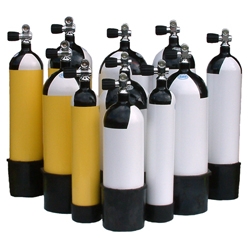 Air tanks hold your air whilst underwater, these are highly pressurized up to 300PSI. They can be used to hold compressed air, Nitrox or any mixture of exotic gasses and used individually or in tandem.
Air tanks hold your air whilst underwater, these are highly pressurized up to 300PSI. They can be used to hold compressed air, Nitrox or any mixture of exotic gasses and used individually or in tandem.
In addition many divers dive with a ‘pony bottle’, this is generally about a 3ltr reserve tank with its own 1st and 2nd stages that is intended to be used in emergencies or during deco stops.
Dry Suit
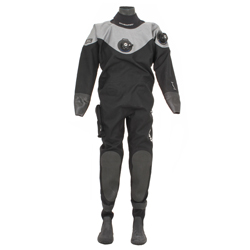 A dry suit is just that its a suit the diver wears to keep them dry hence Dry Suit. It is watertight at the neck, wrists and ankles and is worn over some thermal underclothes, its connected to the air cylinder a for inflation and has dump valves.
A dry suit is just that its a suit the diver wears to keep them dry hence Dry Suit. It is watertight at the neck, wrists and ankles and is worn over some thermal underclothes, its connected to the air cylinder a for inflation and has dump valves.
Scuba fins

Fins or flippers? now that is the question, a real diver will always call them fins and its got nothing to do with Absolute. Fins come in a variety of sizes and materials, with thrust channels and flow vectoring and this and that tech, full foot or open healed worn with dive booties. Basically the fin is an extension of your feet and are designed to create thrust when you move your feet up and down similar to a fan in the air.
Diving mask
 The mask or goggles allow you to see and enjoy the underwater world, without this you would have a pretty poor experience if you actually want diving at all. As all of you know a poorly fitting or leaky mask is a right pain in the proverbial and can really spoil ones diving so getting a decent mask is always advisable.
The mask or goggles allow you to see and enjoy the underwater world, without this you would have a pretty poor experience if you actually want diving at all. As all of you know a poorly fitting or leaky mask is a right pain in the proverbial and can really spoil ones diving so getting a decent mask is always advisable.
Masks are available in a multitude of colours and generally made from plastic, if you wear glasses you can even get prescription lenses in your masks so you have no excuse not to get the most from your underwater experiences.
Regulators
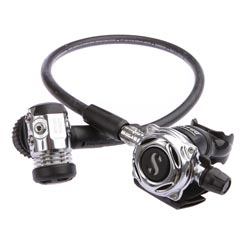 Regulators are what allows a diver to breath underwater, they are made up of 2 stages; first stage and second stage, the first stage reduces pressure to an intermediate level whilst the second stage reduces the pressure to ambient
Regulators are what allows a diver to breath underwater, they are made up of 2 stages; first stage and second stage, the first stage reduces pressure to an intermediate level whilst the second stage reduces the pressure to ambient
First Stage
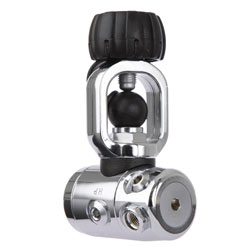 The first stage of the regulator system fits onto the tank neck valve, it connect to several hoses including the high pressure hose where the pressure guage is attached and two second stages; the main regulator and a secondary regulator called an octopus. The second stage and octopus outputs are both lreduced in pressure to an intermediate level which is then reduced further by the regulator.
The first stage of the regulator system fits onto the tank neck valve, it connect to several hoses including the high pressure hose where the pressure guage is attached and two second stages; the main regulator and a secondary regulator called an octopus. The second stage and octopus outputs are both lreduced in pressure to an intermediate level which is then reduced further by the regulator.
Second Stage
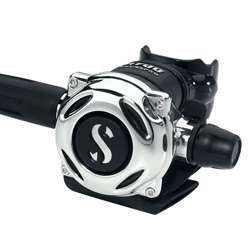
Octopus

And you thought divers had no sense of humour! An ocopus is basically a spare second stage that should in the extrememly unlikely circumstances your own fail or your buddy runs out of air (much more likely) then there is a spare reg to use.
Weight Belt
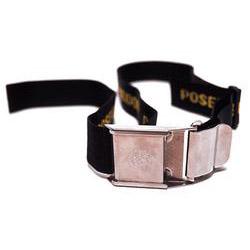
So why do you need weights? well you are by nature generally positively or neutrally boyant, also that wet/dry suit will add boyancy especially if you have a thick suit or lots of thermal layers, also salt water is more dense than fresh water so ….. So descending through the first few metres is the hardest and you need some help so throw on a few kilos of lead and you’ll sink like a stone.
Wet suit
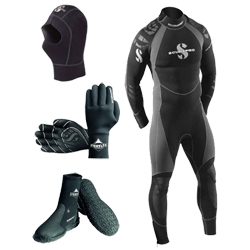
A wet suit is designed to allow a small layer of water to exist between the divers skin and the material of the suit, the warmth of the body then heats the layer helping to insulate and keep the diver warm. Water can enter and exit the suit as the cuffs, ankels and neck are not sealed, this creates a flushign effect. Wet suit are available as full length including full arms and legs or as ‘shorties’ which cover as far as a T-shirt and shorts would do.
Shorties are fine for tropical diving but not so great in UK waters!!!, only the hardy will wear a wet suit in the UK.
Please note we do not actively support any brand and the images here should not be seen as preferences or recommendations
